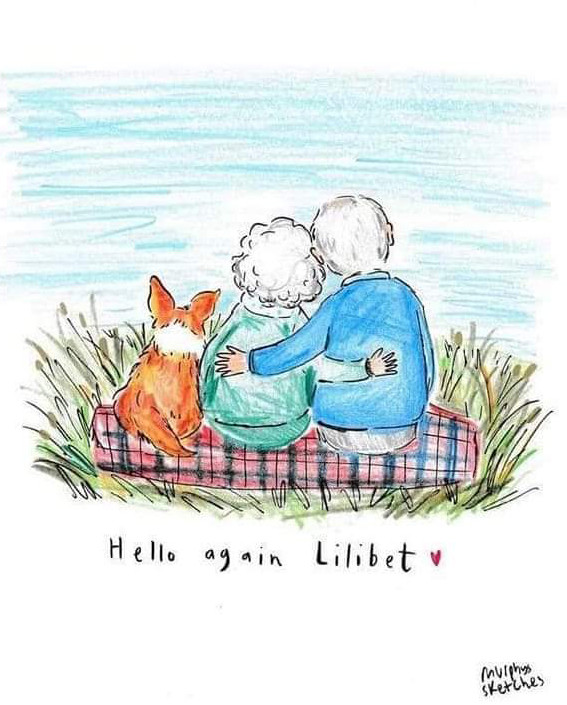On 2nd September we received the welcome news that WUF now considered the rivers cool enough for all types of fishing to go ahead. At the same time the weather was obviously changing to some extent as high pressure gave way to low and at last rain was predicted. However, anglers were still left waiting and hoping for better times as the few intermittent showers arriving seemed to produce very little extra water in our river channels and in some cases none at all. There was certainly more rainfall further west and to the north. Up in the north-east the Tees continued to produce good results. BD from Newcastle on Tyne managed 11 trout at the Raby Estate, GA from Leven with a friend had a trout and 17 grayling between them at Coniscliffe. CM from Bicester fishing at Egglestone Hall caught 4 trout and 3 grayling on dries: specifically an Adams and an F-Fly. Meanwhile RF from Dartmouth with a friend had a 2.5 pounds trout with a nymph from the Usk at Penpont. This was a specimen fish on a day which was otherwise very difficult. RP from Walsall with 3 friends enjoyed a day at Dolgau on the upper Wye, reporting 3 trout and 40 grayling. JG from Kent fished the Welsh Dee at Llangollen Maelor and took 5 trout and 20 grayling to 42cm with the duo system.
 Slow fishing - MH from Wolverhampton
Slow fishing - MH from Wolverhampton Coarse angler JP from Bristol gave up after 2 hours trying to fish the Wye at Wyastone Leys due to low water and blanket weed and complained: “If the river is to be in this condition, anglers need to be advised.” With all respect, anglers also need to advise themselves. This didn’t happen because of some failure of the fishery owner or the letting agent. We have now experienced a late spring and summer of drought, one of the worst on record. The mainstream media has reported the fact on a daily basis, the WUF has been writing about it, I have certainly been writing about it, as has every other commentator including almost everybody who filed a catch return. If you book a day’s wild river fishing in high summer after months of drought, you can expect the fishing to be tough. When planning a fishing trip, it really pays you to check the weather reports, the water gauges, and indeed the catch returns to see what is going on. Pick your time according to the seasons, the water levels and the weather as well as the time you have available.
On 4th September about an hour in total of light rain fell where I live near the lower end of the Wye. Unimpressive, I thought to myself, having recently experienced similar showers with no effect at all on the rivers. Early on the morning of the 5th I checked the online gauges to find Llanstephan showing something under 5 inches, and the Rhayader gauge almost dry, much as it has been all summer. But further upstream at the top of the Wye the water was now rising and the EA gauge on the Irfon tributary was showing 0.85 metres. This amounts to a flood on that river and it was already having an effect on the main Wye as it discharged at Builth. Clearly there must have been proper heavy rain in the Cambrian Mountains during the night. Similarly, rain on the Beacons had reached the Usk as far as Brecon, where the gauge briefly showed an extra foot of thick red water. Further west, the Towy was already in proper flood with 1.65 metres on the gauge at Manorafon and the Loughor came up also. This was just what local anglers had been waiting for and they were soon out on the rivers with spinning rods. Friends caught salmon and sewin to 9 pounds from the Loughor and I was shown a photograph of a double figure monster from the Towy. We also began to hear of fish from the Teifi. These rivers stayed high and were good for day-time fishing for a while. Later, as you might expect, fly fishing by night was the preferred method. High spring tides will have helped to bring fresh fish in. There was also some good bass fishing around the Gower. I would have loved to head west down the A40 to join the fun, but with a full diary I couldn’t find a free night with the necessary following day for recovery. I always feel like I have a hangover after night trips – maybe I’m getting a bit old for hard-core sewin fishing!
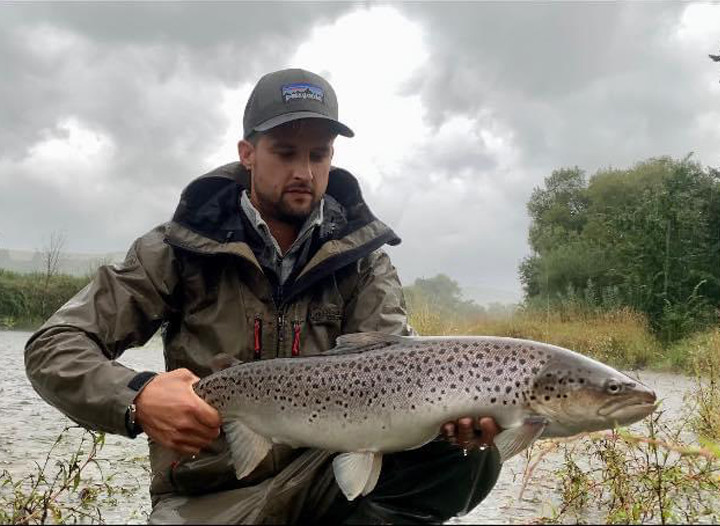 Towy monster
Towy monster 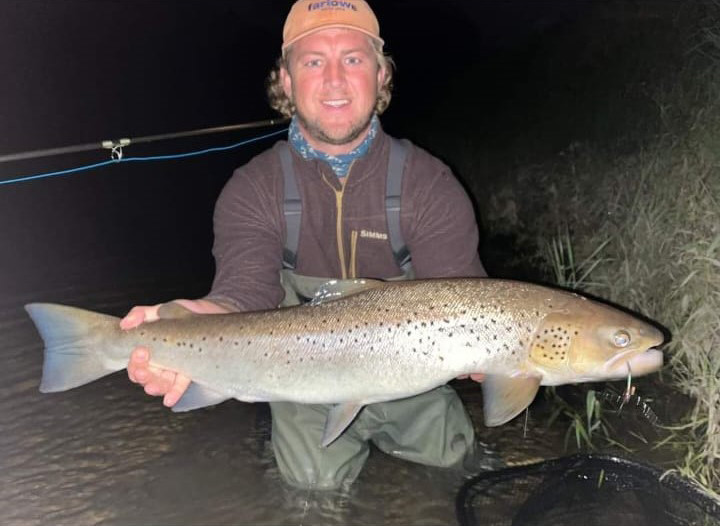 Towy nights - Colton Kelly copy
Towy nights - Colton Kelly copy CE from Worcester had an interesting day at Cefn Rhosan Fawr at the top of the Usk, which was now also slightly up and coloured. Nothing daunted, he pressed on with nymphs and took 4 trout to an impressive 2.75 pounds. The showers kept coming now with stacks of cloud driving overhead, and these produced several small waves of water rolling down the main rivers, but without any lasting change in the levels. I had expected a very dirty flood, but in fact the Wye ran quite clear. Still, the modest amount of fresh water received must have done us some good. WB from Langenfeld caught 12 trout to 16 inches from the Usk at Dinas, mainly on wet flies. GW from Cheltenham with a friend had a very good day at Lyepole on the Lugg, catching 4 trout and 37 grayling, mainly on nymphs under a dry fly. MR from Clwyd with a friend had a 16 inch trout in a bag of 6 from the Usk at Cwmwysg Ganol.
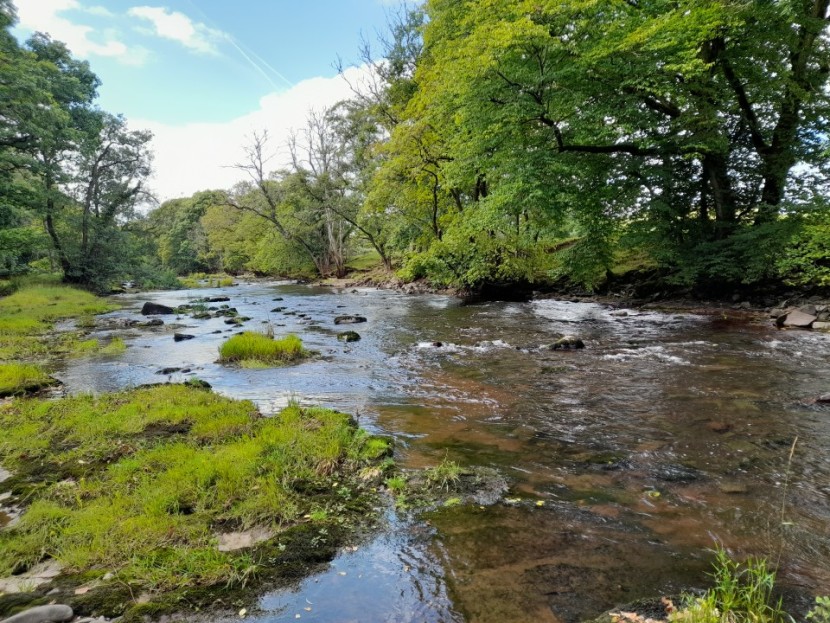 Cwmwysg Ganol - BG from Exeter
Cwmwysg Ganol - BG from Exeter 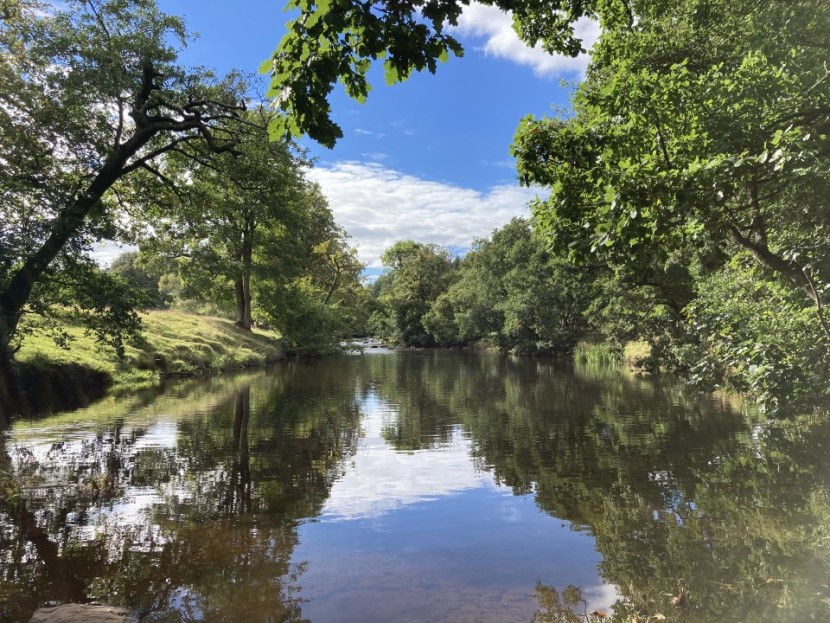 Cefn Rhosan Fawr - JH from Cheltenham
Cefn Rhosan Fawr - JH from Cheltenham 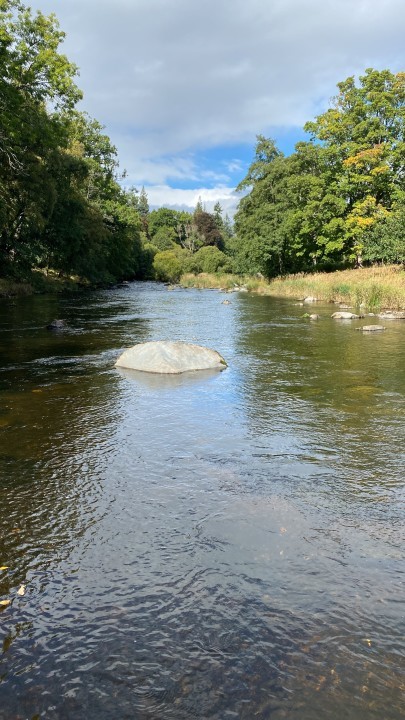 Dolgau - FR from Hereford
Dolgau - FR from Hereford We were now in the sombre week of royal mourning. Angling is a contemplative rather than a noisy sport, and I very much doubt that HM would have been offended by those of us who were grateful to get away from the wall to wall television coverage and out into the fresh air.
On the 11th BP and SH from Gloucester took 1 trout and 17 grayling at Craig Llyn, where they had a nice rise of fish during the afternoon. WD from North Nibley also found rises at Dolgau, where he took 1 trout and 9 grayling. JM from Salcombe took 1 trout and 8 grayling fishing dry at Abernant, using Grayling Steel Blue and a Deer Hair Emerger. He encountered the otter and trespassers who insisted on picnicking by the river. Given the water levels, still very low, there was little to report about salmon fishing, although regular DC of Mountain Ash hooked and lost a fish on his favourite Llangoed and Lower Llanstephan beat. He was using a size 6 Green Highlander, which is a nice traditional touch. On the 12th OS from Darlington reported a salmon from the Raby Estate water of the Tees. I liked the report from coarse fisher ST of Bristol who with a friend fished the Trelough Pool on the following day: “The only lake on earth where you don’t have to fish next to loads of people. You have the entire lake to yourself. Total Bliss.” They caught 6 carp to 13 pounds.
AM from Dorridge had a good day at Lyepole on the Lugg, reporting a large catch of grayling and 2 trout on an Endrick Spider, while RB from Redditch had 7 trout, 18 grayling and 3 chub from the Wye at the Rectory. JG from Monmouth fished the little Dore at Abbeydore for 3 trout and 5 grayling. On the 15th PB from Churchdown with a friend fishing parachute dries on Llangoed and Lower Llanstephan caught 4 trout to 18 inches and 25 grayling to 17 inches. Dave Collins from West Herefordshire fished at Ty Newydd, noted the massive movement of gravel which has occurred there since last year, and reported 6 trout and 8 grayling, mostly on dries.
We had very mixed results during the second part of September. By this time some quite cold nights were probably starting to have a good effect (I saw a ground frost in a hollow for the first time this year on the 16th) and some super catches of barbel and chub were being reported from the middle and lower Wye. On the other hand, although the water had cooled, most of our rivers were still extraordinarily low. JE from New Malden reported at the end of a difficult day on the Edw: “Spoke to a local on the way back to the car. Said it was the lowest the river had been in 90 years and struggling to recover with hard ground and low aquifers. Quite depressing really.” I can sympathise with the remarks about low water, having seen areas of river bed I have never had a good look at before. CW from Upton remarked about the Monnow at Skenfrith: “River level is extremely low. It’s not really fishable. I would avoid and allow it to recover.” On similar lines, MP from Swansea was unhappy about the access to the Usk Reservoir, where large areas of silt are exposed.
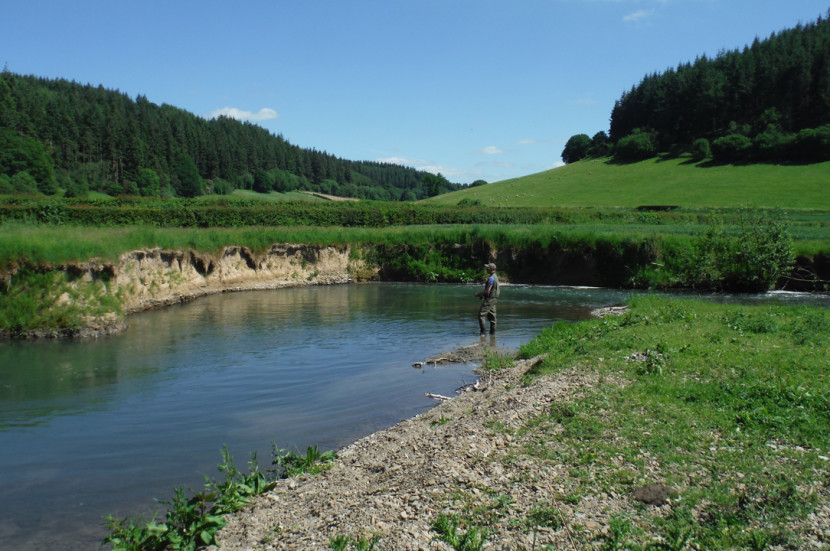 Lyepole
Lyepole 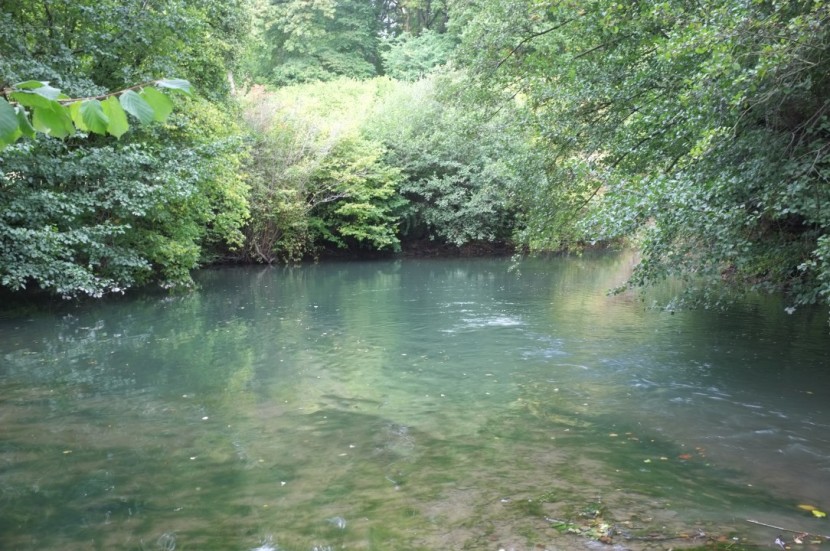 Lyepole pools - KP from Crickhowell
Lyepole pools - KP from Crickhowell There was some reasonably good fly fishing at times, although anglers had to work for it. A couple of inches up and down in the river levels due to random showers seemed to switch the fish on and off. Water temperatures were now down to about 14 or 15 degrees. On the 16th AF from Stroud had 5 trout and 10 grayling, mostly small, fishing at Abernant with spiders. DM from Swansea reported 12 trout and 3 grayling from Ty Newydd on nymphs – there were no rises. BW from Stratford on Avon had 1 trout and 15 grayling at Lyepole using both nymphs and dries. AM from Dorridge had 8 grayling at Doldowlod, mostly on dries. And BP from Pembridge had 10 trout on a Bibio Hopper up at Llyn Bugeilyn while a cold north wind was blowing. NS from Brentford who fished at Abercynrig on the Usk raised that vexed problem of anglers poaching over the boundary with Dinas again. The boundary, clearly marked on the map provided to all ticket purchasers, is the Cynrig tributary stream. You can hardly miss this feature. The WUF feel, reasonably enough, that it should not be necessary to put signs on the stream stating that this is the beat boundary. This reminds me of the fun and games we sometimes have over the bottom boundary of Goodrich Court on the lower Wye, which is marked with a yellow post. As a day ticket purchaser, please read the notes sent to you and make sure you know where the boundary is. In the case of Dinas and Abercynrig, when you get to the stream, fish no further, however attractive the other side looks…unless of course you have booked both beats!
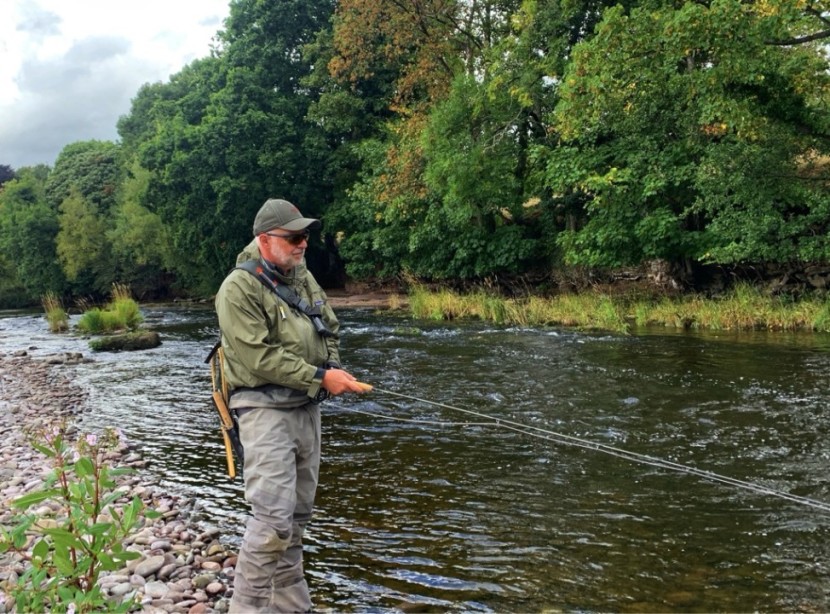 Dinas - WB from Langenfeld
Dinas - WB from Langenfeld 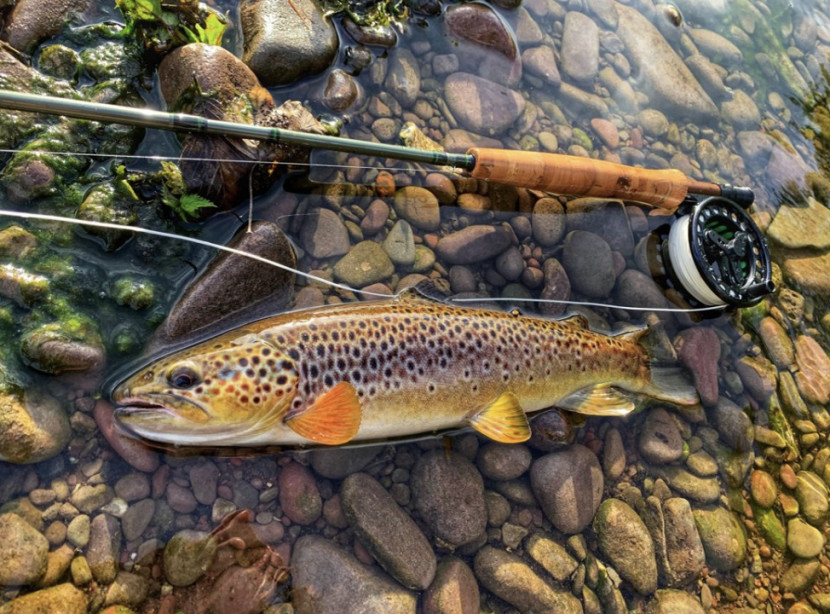 Dinas trout - WB from Langenfeld
Dinas trout - WB from Langenfeld LD from Swansea fishing on the 19th had a fine day up at Llyn Berwyn, fishing dry flies around the edge for 14 trout, some of which were quite hefty. Llyn Berwyn has always had a reputation for good dry fly fishing. AF from Stroud fished the upper Wye at Llangoed and Lower Llanstephan for 4 trout and 7 grayling. NM from Lingen fished the Lugg at Lyepole for 1 trout and 8 grayling. DN from Carshalton fishing Holme Lacey 3 and Lechmere’s Ley on the 21st was another who recorded a remarkable catch of coarse fish; he reported 3 barbel and 86 chub. PV from Tilburg in the Netherlands with a friend fished at Craig Llyn on the 21st and they reported 10 grayling on small CDC emergers. PV fished alone at Lyepole the following day and although he caught 14 grayling he had much to say about the amount of filamentous algae as a sign of excess nitrates, phosphates and general eutrophication of the water. His party had only come to Wales, he noted, because the famous streams of the French Jura have already been similarly damaged by eutrophication. So beware! Well PV, we know, we know, but it’s sad to hear that these apparently local problems are actually so widespread. To be honest, and while I can see why conditions at Lypole looked different from those at Craig Llyn, I am not quite as worried about the Lugg as I am about some other Wye tributaries. On the other hand there is now an urgent need for some branch trimming and style repairs at the very popular Lyepole beat. TM from Somerset with a friend had a decent day at Craig Llyn on 24th, reporting 3 trout and 19 grayling by various methods. JT from Bristol fished the Abergavenny Town water late in the evening with nymphs to take 8 brown trout. AB from Cardiff found the Middle Llynfi Dulas pretty much unfishable. See his pictures of the little river almost choked with green slime.
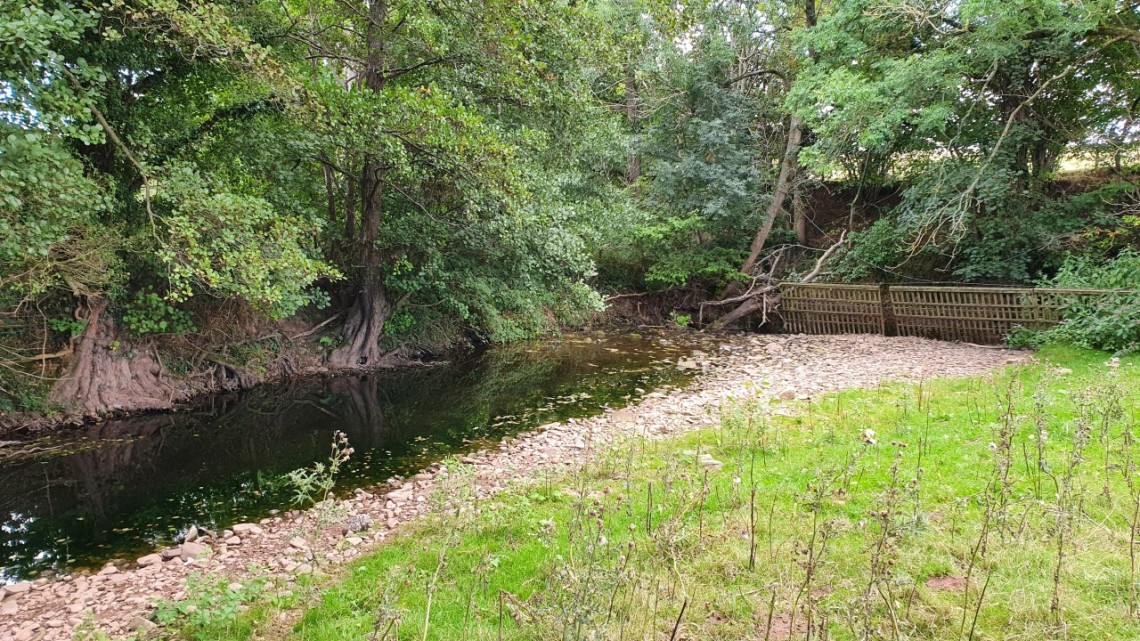 Llynfi Dulas Middle - AB from Cardiff
Llynfi Dulas Middle - AB from Cardiff In these decidedly uncertain conditions, MH from Swansea was one angler who had a good autumn day. He found the Wye at Gromaine and Upper Llanstephan risen just a couple of inches following overnight rain, air temperatures were down and both trout and grayling seemed to have been sharpened up into a taking mood. Using both dry flies and nymphs he took 14 trout to 2 pounds and 12 grayling to 15 inches, a result could be considered really good fishing anywhere and at any time. CB from Caerphilly sent in one of those negative reports about Llwyn On: “My friend and I blanked for the fourth time in a row. They obviously aren’t stocking the lake.” Well, that might be one conclusion, I suppose. Can you think of another? In fact most Llwyn On anglers reported something, despite the conditions. PB from Ludlow reported 12 grayling from Lyepole: “a great place for fly fishing.” RD from Lower Boddington visited the Half Moon beat, right at the top of the Honddu in the Black Mountains, and found it to be quite unfishable due to lack of water. On the 29th, AP from Haverfordwest plus two friends fished Llyn Teifi for 23 trout. Crane flies were blowing onto the surface and they caught their fish on Black Hoppers. MT from London had 6 trout from the top of the Wye at Upper Clochfaen.
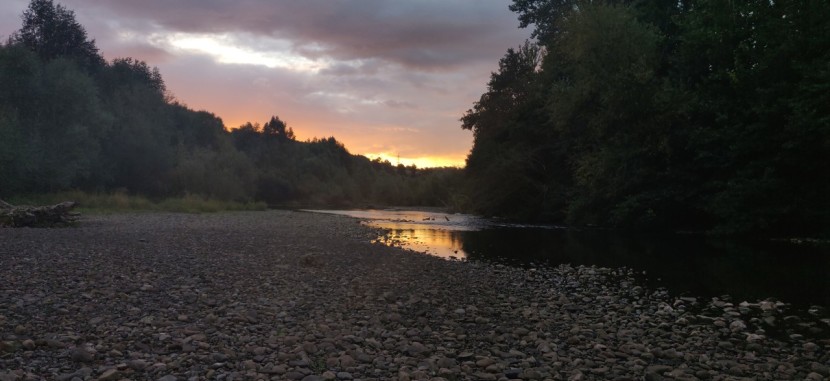 Abergavenny Town Water - JT from Bristol
Abergavenny Town Water - JT from Bristol 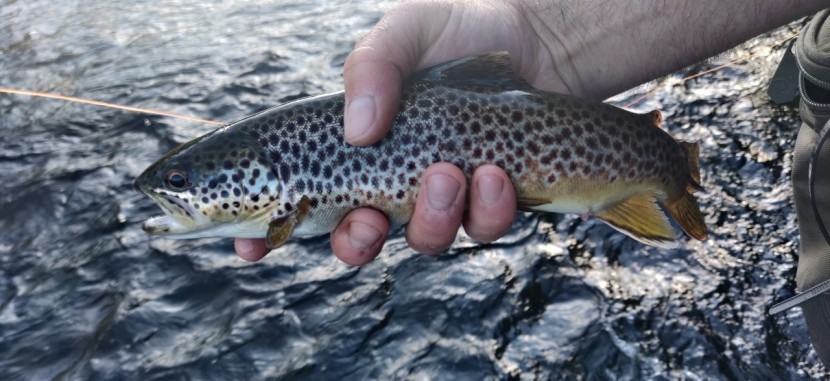 Abergavenny trout - JT from Bristol
Abergavenny trout - JT from Bristol For the final 2 weeks of September there was next to nothing to report on the salmon front. On the 16th SW from Bristol lost a good fish in the Upper Rocks on the Usk’s Chainbridge beat. ME from Pontypridd, lucky or unlucky depending on your point of view, carefully released a coloured salmon hooked accidentally while nymphing for trout at Glanusk Estate. On the 19th the Wye Salmon Association advised members to hang up their rods for the remainder of the season. However, most Wye proprietors seem to have ignored the advice and kept their beats open. On the 23rd, citing water temperatures now reduced, the EA changed the Wye status from Amber to Green, and advised anglers to have a care when releasing delicate species such as trout, grayling, salmon, barbel and pike. On the last day of the month, Friday 30th, we had an afternoon of proper heavy rain as a front swept from west to east across the country. This may not have added up to so much in the total scheme of rainfall, but I did hope it might do some small amount of good for some-one at the top end of our rivers. (And in fact it did, but that is for next month’s report).
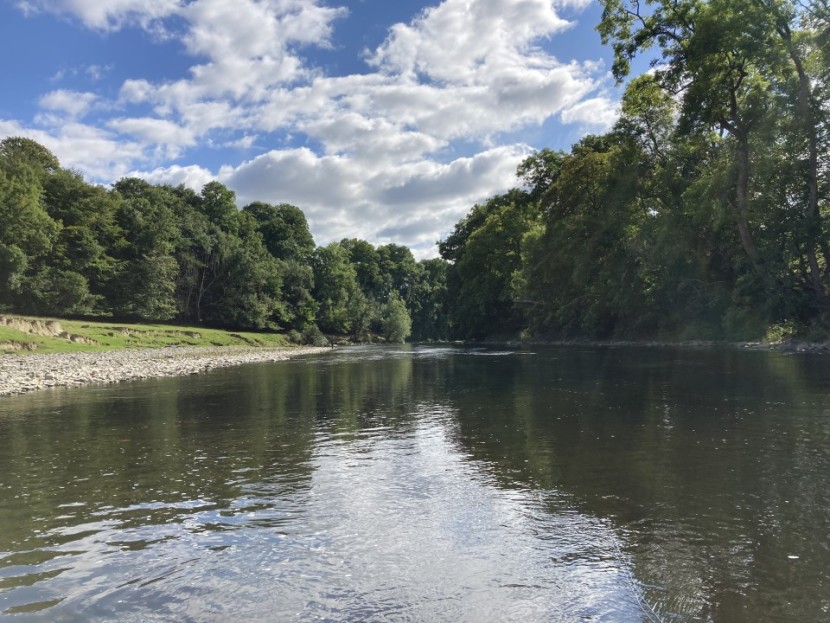 Abernant - JH from Cheltenham
Abernant - JH from Cheltenham 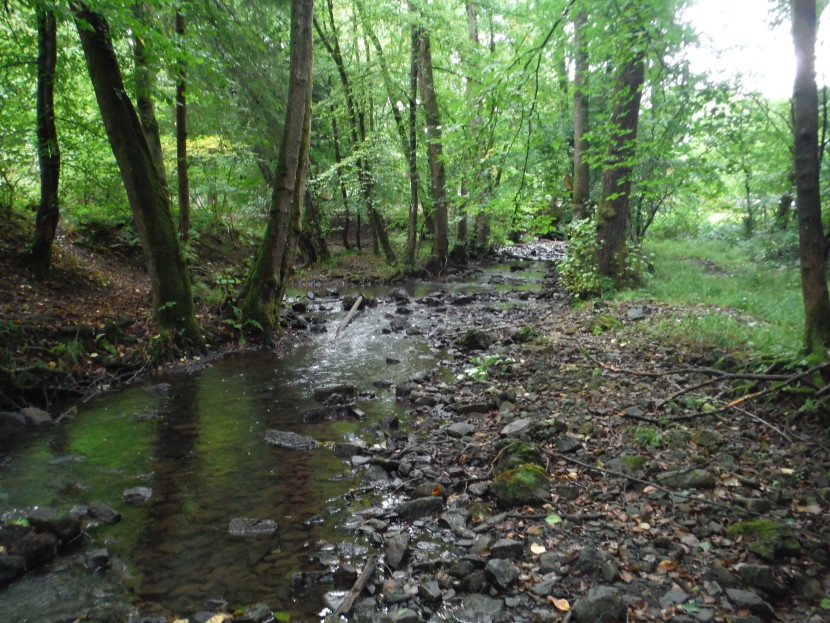 Cannop Brook
Cannop Brook Grayling as a species delight me especially when they take a dry fly, but sometimes they can tease. I find myself learning this anew every autumn. The other day I was out on the Lugg with a client and we came to a likely pool. We had been fishing a team of nymphs with reasonable success so far that day, but now we began to see rising fish and it seemed a good idea to change the method, so I put a dry fly leader on. The cast was a slightly awkward one, diagonally up and across the main current running into the pool under alder branches to reach a deep and slowly rotating eddy where the surface was littered with dead leaves. There didn’t seem to be any grayling in the run, but intermittent rises were certainly occurring in the eddy. Drag from the run made it difficult to keep a dry fly in place for long, but my client sent a little Grayling Steel Blue up there and after a few seconds got what looked to me to be a pretty good rise. The fly disappeared in a whorl and he struck, to connect with nothing at all. Well, nothing ventured nothing gained, so he tried again. Again a grayling came up, quite a good one by the look of it, and again no connection. After five or so misses he suggested I have a go, but I could do no better although I was also getting takes. I normally reckon to strike a grayling faster than a trout, but on this occasion I tried striking fast, striking slow, and everything in between. Were they completely missing the fly tethered to its leader, or were they deliberately drowning it? I found myself checking the hook point on the fly and looking to see if the hackle was obstructing the gape. Now the grayling, having done everything except take the fly properly, seemed to be just coming up to look at it. I put on another pattern to see what effect that would have and the rises stopped.
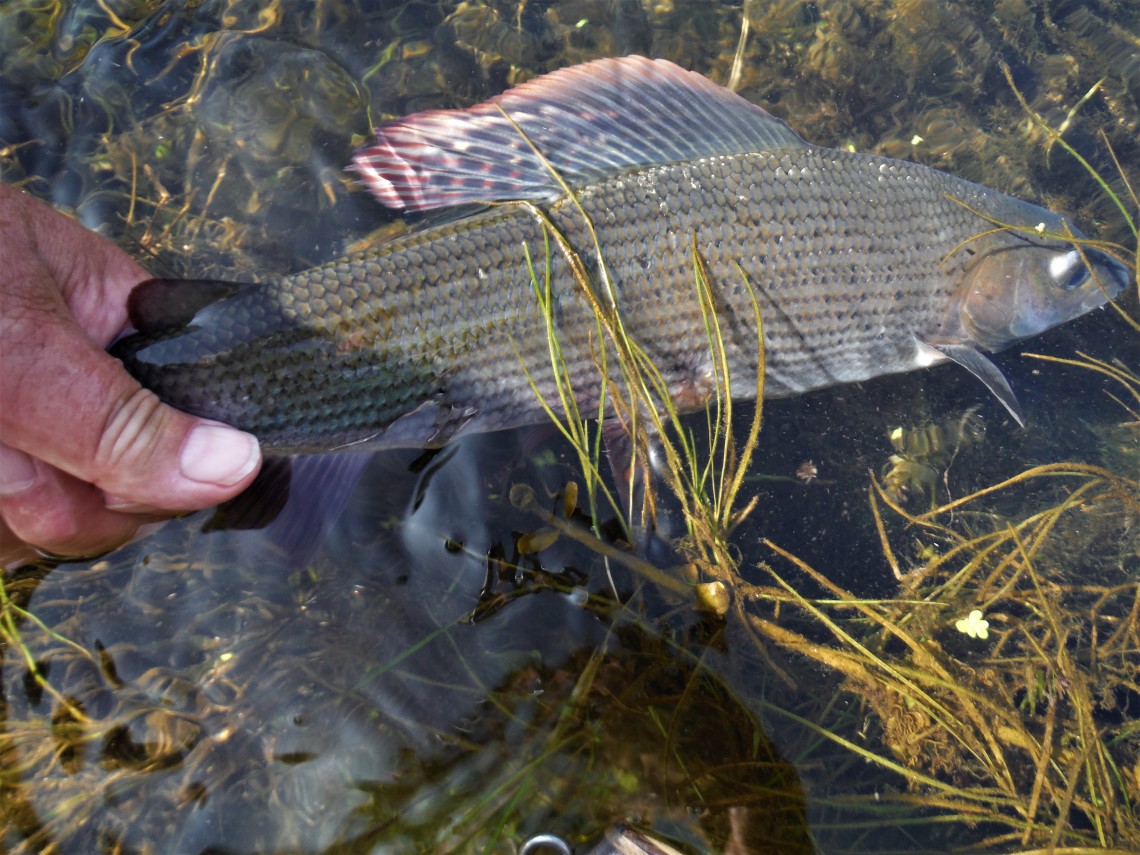 Avon grayling
Avon grayling Moving on to the next pool, my client rose three grayling and hooked one. But from then on, progressing upstream until the end of the day, I think that without too much trouble we connected with every grayling we rose, all the fish being solidly hooked in the roof of the mouth. Righyni remarked on this tendency of grayling to playful behaviour with a fly sometimes, but counselled that sooner or later on such days, the grayling would stop flirting and start to take properly. I have always found this to be the case, and it usually happens before the unfortunate angler goes quite mad with frustration! On reflection, there are similarities with other species. Under some weather conditions sea trout can continually nip and tweak at the very tail of a fly, somehow without getting hooked. Falkus claimed to have the problem licked with his “secret weapon” style of fly with a small flying treble at the rear, but my experience was that on some nights those pesky sewin managed to tweak even these without becoming hooked. In the days when we had a lot of salmon in our rivers, there were almost inexplicable times when most fish hooked were lost and there were many half-hearted plucks at the fly beside. And of course thankfully there were other times when every taking fish hit the fly solidly.
The autumn edition of Trout and Salmon carries an article by small still-water specialist Peter Cockwill about trout hybrids. Now I imagine that most of us who fish the WUF waters dream in our beds at night about catching beautiful wild brown trout, grayling, salmon and perhaps sea trout, or in other words, the natural fish native to and born in our rivers. Now that is fine and understandable, but we must accept that there is another fishing world in which fish are reared to be stocked and caught, and that this world gives a great deal of pleasure to a large number of fly-fishers. I’m not such a purist that I want to turn my back on the world of commercial fishing. I recognise its place and its value, and I turn to it myself when our rivers are in flood or out of season.
 Native trout from a Forest lake
Native trout from a Forest lake I also accept that a century and a half of stocking British rivers with trout has not yet come to an end and nor is it likely to. Most chalk stream fisheries are businesses which would not survive without it. However, I’m grateful that in almost every case the trout now being stocked are brown trout, and triploids to boot, which cannot interbreed and thus pollute the gene pool of native fish. They do, of course, compete with native fish for food which is a factor to be considered in each case. I find it hard to state exactly why, but I never was happy with the idea of stocking rainbows in British rivers. It seems to me they belong in a couple of rivers in Derbyshire where a breeding population has been established and otherwise in their native rivers to the west of the Rocky Mountains. For all that, you will now find rainbows in rivers all over Europe, in the Eastern USA, the highlands of Sri Lanka and East Africa, in the southern hemisphere, all over the world in fact. Rainbows are a great sporting and stocking species, easy to breed, fast to grow, easy to acclimatise. It’s just that somehow I don’t want to see them competing with browns in my local rivers or in natural lakes.
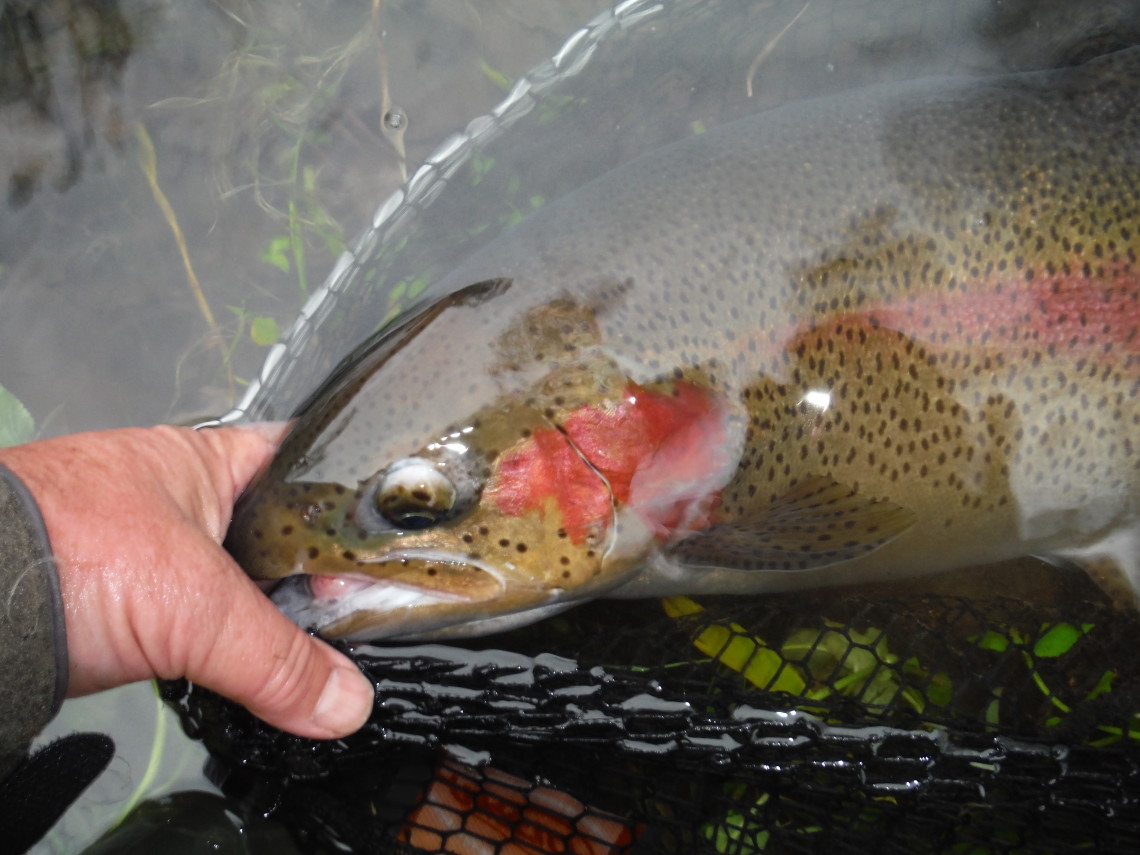 Oversized rainbow
Oversized rainbow If, on the other hand, you want to stock them in man-made reservoirs or ponds, why not? All the syndicate forest pools and commercial fisheries in my area buy rainbow trout bred on Exmoor and stocked at a standard 2.5 pounds (which is just about cormorant-proof), occasionally and when available stocking a sprinkling of larger fish between 3 and 5 pounds to add a little excitement. Inevitably there has been some breeding experimentation by the fish-farmers to provide a curiosity and interest for their customers. As Cockwill points out in his article, the idea of breeding enormous rainbows to 30 pounds in order to break records has apparently had its day, for which I am quite grateful. I have sometimes heard a non-fishing bystander remark with enthusiasm: “That’s a big one, well done,” as a hefty rainbow is netted from a pool. In most cases the appropriate if slightly dispiriting response is: “You only get out what you put in.” As far as I am concerned, a fit 3 pounds rainbow which gets its speed up and strips the whole line out is as sporting a fish as you will encounter in such a pool and as large a fish as I would wish to catch there.
Some other species have been experimented with in the UK, including arctic char in waters which they would not naturally contain and, on various occasions, beginning during the 19th century, American brook trout, which is also a kind of char. As the Americans say: “There are brownies, rainbows and cut-throats. Everything else is char.” If you take the purist approach, there are only three types of trout in the world. I can remember catching American brook trout which had been stocked during the early days of Bewl Reservoir. Generally these experiments were not particularly successful. And of course there are the variants and the hybrids, which some are inclined to describe as monsters. However, when you consider the extraordinary changes which have been made by selective breeding over time of, say, dogs or cattle, the fish farmers have been quite modest in what they have produced. Hybrids of all kinds are generally infertile, but not necessarily useless. Who would deny the value of a working mule - I know what I want when war comes and the petrol is all gone! But in the fishing world, it seems to me the hybrids may have been produced in a quest for a sort of super-strong trout, but in the end achieved no more than novelty value with some different markings on their flanks. Thus on occasions at the commercial fisheries I have caught something called a sparctic, which is an arctic char crossed with American brook trout, and a tiger trout, which is a cross between a European brown trout and an American brook trout. I didn’t find either of them particularly exciting. Cockwill also informs there is another called a cheetah trout, which is a cross between a rainbow and an American brook trout, but very hard to produce. My immediate thought about that is: why bother?
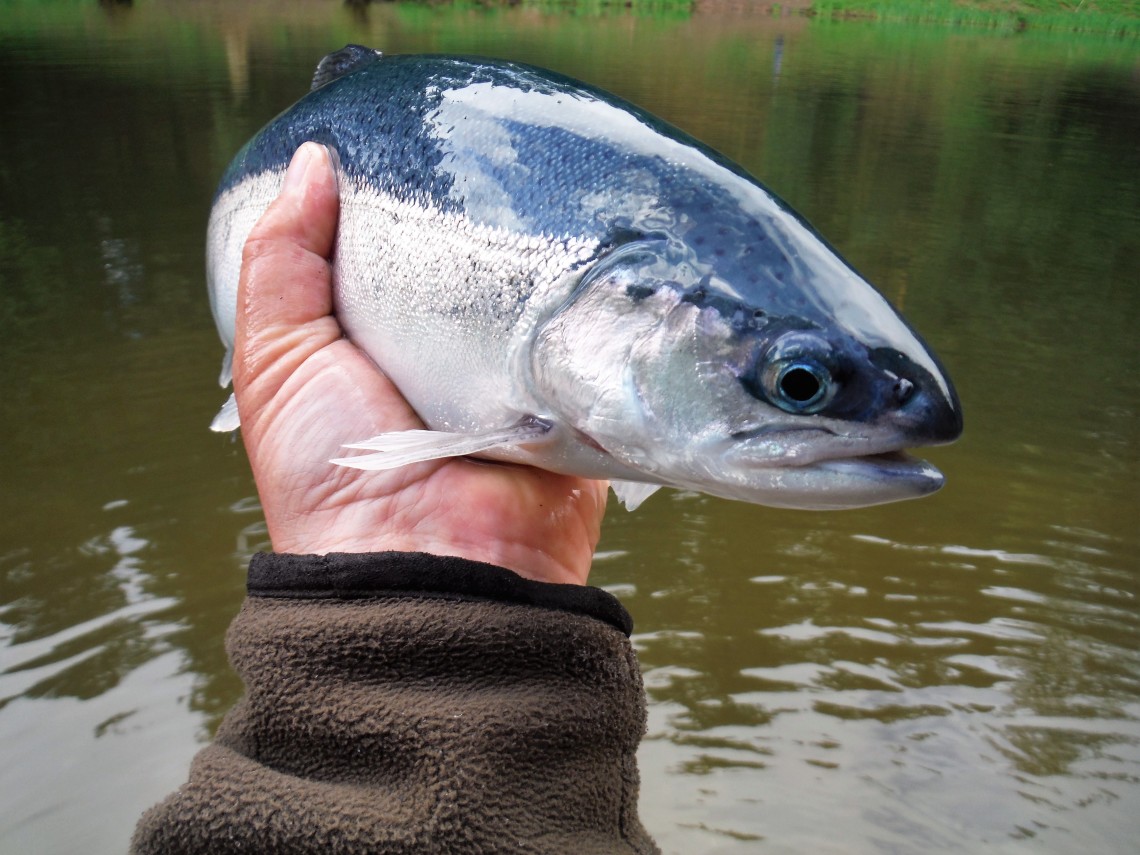 Blue trout
Blue trout In the case of rainbow trout, we have two original strains currently in use for fish breeding: Shasta from California and Kamloops from British Columbia. There are some interesting colour variants. We used to see golden trout, which was a rainbow trout variant evolved in the USA, although not, as I originally thought, an albino. They looked very nice, like huge golden orfe, but showed up in the water so well that every angler targeted them and they quickly became extremely spooky. On the other hand, they tended to cruise in company with unseen shoals of darker rainbows below, and so were a useful marker. Blue trout are a variant which I do rather like and which most customers will cheerfully order for their lakes when they are available. I don’t know the reason, but blue trout always seem to fight extremely well and their livery of blue and silver is truly beautiful, almost like that of a blue shark. Even their eyes are blue. Their cruising habit is slightly difficult to that of regular rainbows and they seem to like the margins of pools. Finally Cockwill makes the point, and I will reiterate it, that it is illegal without an EA permit to release non-native trout species or hybrids into the wild.
It has been a sad month of course. That particular afternoon of 8th September, the one which I suppose we will all remember, I had gone down to the estuary to shoot a couple of games of down the line trap with the local wild-fowling club. Once over the main South Wales railway line you find yourself in a remote riverside field. People pay a lot of attention to the background when shooting these rapidly fleeing targets. In this case, beyond the stands and the trap house you look over a bank at nearly two miles of bright water or wet sand reflecting the sky, according to the flood or ebb of the tide. Occasionally there is a freighter making its way up the far side channel to Sharpness. This shoot is normally a very sociable and cheerful little meeting, but on this occasion there was already a slightly sombre cast to the mood. People were saying that this time the news from Balmoral really did sound quite serious. The weather that afternoon was stormy with tall black cumulus clouds full of rain marching inland from the Bristol Channel. There were sudden and intense showers, and rainbows over the water on occasion. It was only when we were finished, had taken the cars back across the railway and closed the crossing gate that somebody got the news on the radio that the Union flag on Buckingham Palace was flying at half- mast.
Like many others, I hadn’t realised that when it came to it, when the inevitable happened, I would feel so depressed. Driving home, it struck me that what I would have liked to have done, maybe what we should have done, is go back down to the range, line up again and fire a salute to a great lady. During the next 24 hours almost every public figure you could imagine, even President Putin, sent messages of admiration for the Queen’s life and sympathy to her family for their loss. The death of somebody nearly a century old is hardly unexpected, but Boris Johnson, who delivered the most inspired of the eulogies in Parliament, expressed it best when he said we had all been rather like children, somehow hoping illogically that she would go on forever and the world would never change. The rule of Queen Elizabeth II lasted through nearly all of my life and indeed the number of people remaining in the UK and the Commonwealth who can remember earlier reigns must be much diminished.
The Queen was of course herself one of that now rapidly shrinking band who went through World War II. My own mother, had she survived, would have been almost exactly the same age as the Queen and had a similar experience, working in the Air Ministry through the last years of the war. Mother was certainly well aware of that age match, and as dementia took a hold during her final 10 years began to see herself and the sovereign as best mates. There were other times when I think she believed she was the Queen. “I have tea with the Queen once a week,” I overheard her telling a bemused carer once. “Usually on Tuesdays. Not a formal tea you understand.” About this time the family doctor marked her case notes with the single word: “Grandiosity.” On another occasion the same carer heard: “The Queen and I have a lot in common. We are both very disappointed in our sons.” A bit hard on Charles that, I thought to myself.
I can hardly add to the words of praise coming from all quarters for the life and service of Queen Elizabeth II. By the time you read this letter, you will have read a dozen eulogies and listened to a full week of intense media coverage – too much, some would say, but during the week of mourning our country never seemed so united. I certainly learned some new information about our constitution. My wife very much wanted to go to the lying in state, although she was committed to work appointments. Instead she sent a loyal email, which, to our surprise, was actually read out on GB News. And like everybody else, we watched the state funeral on television. Who could avoid being impressed by the solemnity of the funeral march through London or the magic of the solitary pipes fading into the distance as if bearing a soul out of this world? I also loved the singing in the chapel at Windsor of the Kontakion of the Departed, which was chosen by the Queen herself and must have been a tribute to Prince Philip’s Greek Orthodox connections. You might recognize it as the same Byzantine chant which makes the opening scenes of David Lean’s Dr Zhivago so dramatic.
I do have a few random thoughts remaining, though. It strikes me that while our system of a constitutional monarchy and democracy with balanced powers is remarkable and surprisingly successful, there is something particularly special about female monarchs. This must be connected with ideals of motherhood and protection. It was famously theorised about the first Elizabethan age and its symbolic Virgin Queen that, for a nation recently turned away from Roman Catholicism, Elizabeth I filled the gap left by the Virgin Mary as a symbol and object of worship. The importance of the Virgin Mary, Mother of God, to the faithful of the Catholic countries of Southern Europe, indeed Poland and Ireland, is virtually undiminished to this day. I see that a wooden statue of the Virgin has just been carried down the Wye, in an attempt to protect it from pollution. “Mariolatry!” the late Reverend Ian Paisley would no doubt have roared from his Protestant pulpit in Belfast if asked for an opinion about this. But then, looking further back, the figure and attributes of the Virgin are often suggested to be a survival from those of earlier deities such as the Phoenician Astarte. In the Orthodox religion and iconography of Cyprus, there is a distinct confusion at times between the Christian Mary and the ancient goddess Aphrodite. Down the centuries there has always been a need, so it seems, to place faith and trust for protection in a female figure. One hot spring morning in 1993 I came across a 19 year-old Croatian soldier in Mostar. A hand grenade had just been thrown at him and though unhurt, he was deeply shaken and indeed surprised. “The Virgin Mary must have protected me,” he kept muttering to himself while fingering a gold crucifix at the neck of his tunic.
One great legacy which the Queen has left us is the Commonwealth, which she did so much to bolster and support and which remains an extraordinary alliance with huge potential. She was head of state of 14 out of 56 nations, which themselves comprise a third of the earth’s population. A few years ago there was a common tendency to view the Commonwealth as not much more than a hangover from empire, and not really relevant in the modern world. Queen Elizabeth worked hard to change that. It’s a broad church now, the Commonwealth, and an easy club to belong to. Several developing nations which never had connections with the British Empire have seen it in their interests to join. Outside the EU now, the UK really has an opportunity to take advantage of connections old and new, along with shared history and friendship, in a commercial sense and in every other way. It must have been hard for Commonwealth countries, all those years ago, when we signed up to a closed market arrangement in Europe, rather than continuing the old trading arrangements across the world. No more Jamaican cane sugar, because we must now buy beet sugar from Belgium. It must have seemed that the mother country was turning its back. Hopefully we will be forgiven.
A very telling remark once made by the Queen was that she didn’t get much of an apprenticeship at the job. In her case, there were no long years of preparing. Her father died unexpectedly young, so that at 25 years old she was suddenly given the huge task and responsibility of becoming the sovereign of what was still an empire. I liked the words she used about this period of her life in a later speech: “In my salad days, when I was green in judgment…” Not so very green for long, I would suggest, because she took every opportunity to learn, beginning discussions with Winston Churchill as her first prime minister. Since then her reign has become an exemplar for public service and restrained wisdom. Her eldest son Charles by comparison has had a very long apprenticeship and I believe perfectly understands and believes in the same requirements of tradition and service followed by his mother. Charles has been a political activist up to now, with known strong views about ecology, the environment and other things. Fair enough, but I believe he knows that in taking on the crown he will follow his mother into that position of neutral silence on political affairs demanded from the sovereign. The rest of us have freedom of speech, or at least we should have, but not the sovereign. Queen Consort Camilla will certainly support him loyally, as Queen Elizabeth clearly recognized. Inevitably the reign of Charles III cannot be so long, but I am convinced we will be in a safe pair of hands. The Archbishop of Canterbury pointed out that the late Queen had always relied on her strong Christian faith, had no fear of death, and thus expected to be reunited with her beloved husband Prince Philip. It certainly would be nice to think so. So the Queen is dead and the second Elizabethan era has ended at last. God save the King!
On a different note, you may already have seen this film and certainly you will have heard about the awards it has won. But one September evening which took us away from current worries, we watched Kenneth Branagh’s brilliant social drama Belfast. If you haven’t seen it, you should. A charming and moving celebration of a childhood, a family and a community during the Troubles, sinister and funny by turns, to describe it as Gregory’s Girl meets Billy Elliot would hardly do it justice. In the end it is a very optimistic film. Music by Van Morrison and thoroughly recommended.
Don’t look up! September was the month during which NASA, having fired a missile at an asteroid clump of compacted rock and dust careering at thousands of miles per hour through space, successfully hit it, thus altering its course very slightly. No sooner has the sci-fi movie been released than the scientists do it for real. It strikes me that whoever calculated that shot would make a very good clay pigeon shooter. The ballistic load used for the impact was apparently about the size of a refrigerator. They could have had my old fridge for nothing.
We have come to the end of the trout season, except for a few Severn tributaries. There are a couple of weeks more for the salmon, although expectations are not very great. However, October can be a lovely month for grayling aficionados. I shall hope to be fishing small dry flies and sometimes spiders. Once proper winter time has arrived, I can look forward to the trotting season and I have already loaded 100 metres of fresh nylon onto each of the centre pin reels. Only, of course, we still need the rain.
Tight lines!
Oliver Burch
